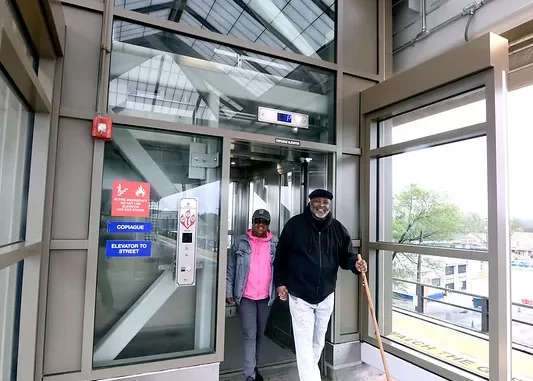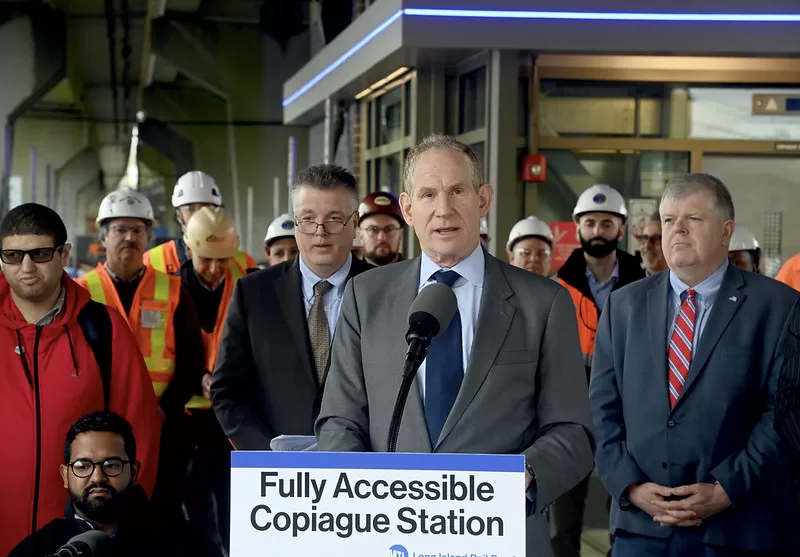
The Copiague Long Island Rail Road (LIRR) station is now accessible to all in accordance with the Americans with Disabilities Act. The railroad now has its first elevator and connecting sidewalk.
This station is the first of three Babylon Branch stations that will be made fully accessible in the next few weeks. Amityville and Lindenhurst are also expected to receive these upgrades before June.
“We are breaking down barriers and ensuring more New Yorkers than ever before can access the transportation they need,” Governor Kathy Hochul said. “I’m committed to improving accessibility across the MTA and ensuring the disability community has a voice and a seat at the table in deciding the future of transit in New York.”
The LIRR received $18 million in federal formula funds which includes money from the Bipartisan Infrastructure Law. This funding supports the $169 million, design-build stations upgrade package at nine stations including Copiague, Amityville, Lindenhurst, Massapequa Park., St. Albans, Laurelton, and Locust Manor. Valley Stream will replace its escalator and elevator. Auburndale will receive replacements to its elevator.

The package includes additional station enhancements including parking and electrical and mechanical improvements, new platform tactile strips and communication and safety security systems, better wayfinding, and new LED lighting and Help Points.
“The MTA has successfully delivered accessibility projects better, cheaper, and faster thanks to innovative contracting tools like project bundling,” said Jamie Torres-Springer, president of MTA Construction & Development. “This station is part of the MTA’s first design-build package of ADA upgrades on the Long Island Rail Road and builds on the great success of the recently completed design-build package of similar accessibility improvements in the NYCT system.”
New York State’s Chief Disability Officer Kim Hill Ridley noted that the grand opening of the elevator coincides with Global Accessibility Awareness Day. “As both a wheelchair user and a mom, I cannot emphasize enough how increased accessibility for people with disabilities benefits everyone else too,” she said. “Now, the disability community, parents with strollers and travelers with luggage from all over the world have increased access to enjoy all that our world-renowned metropolitan area has to offer.”
On weekdays, 51 westbound and 50 eastbound trains stop at Copiague. On weekends the station sees 42 westbound trains and 41 heading east. Copiague is part of the Babylon Branch and also serves customers with connections to Montauk service at Babylon and transfer to NICE buses at Freeport to get to Jones Beach. According to MTA Chair/CEO Janno Lieber, 111 out of 126 stations are now fully accessible “with more to follow.”
MTA Chief Accessibility Officer Quemuel Arroyo said, “This project is just the latest example of a better and more accessible MTA station. These improvements, especially at stations that are elevated, create a significantly quicker and safer trip for customers walking, rolling or carrying children or packages to the platform.”
“With the Babylon Branch completely elevated, modern, working elevators are an essential part of creating the best customer experience for every Long Islander. We are committed to increased accessibility because it creates opportunities for more people to travel throughout the region,” LIRR President Rob Free added.
U.S. Representative Andrew Garbarino (R-Patchogue) said, “Ensuring the LIRR is accessible to all, including those with limited mobility, must be a top priority. I am pleased to see federal funding going towards bringing more inclusivity to our public transportation system and I applaud the MTA for making these improvements to our Babylon Branch stations.”
“The LIRR keeps Long Island moving, growing and thriving,” said Babylon Town Supervisor Rich Schaffer. “As the Town of Babylon looks to create modern, accessible downtowns for families to live, work and play, the ADA upgrades here in Copiague and coming soon to Lindenhurst and Babylon, create a public transit system that is accessible to everyone and is key in moving this effort forward.”

